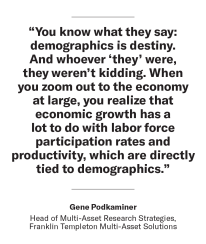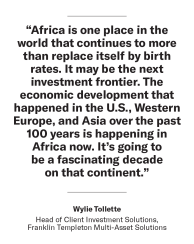In the following conversation, two key players at Franklin Templeton Multi-Asset Solutions – Wylie Tollette, Head of Client Investment Solutions, and Gene Podkaminer, Head of Multi-Asset Research Strategies – talk through the “what if” of demographics, including “do the math but guess the consequences” and mastering “known unknowns.”

Wylie Tollette: Demographic changes are relatively slow-moving. Which is an advantage, but also why it's difficult to call them shocks. You can see them coming. That doesn't mean investing around them is any easier, because they’re so long term that the investment implications are difficult to define.
Podkaminer: The consequences are where we find the shocks. If you take a step back and think about the population of a country, it’s only dependent on three numbers: birth rate, death rate, and net migration. Do the math. The question of the number of kids we’re having is interesting. As lifespans have been increasing in developed markets, the number of children that we have is going down. We’re below the required birth replacement rate to maintain population in a lot of developed economies.
Tollette: As I recall, almost all developed economies are below replacement rate. Two and change is the magic number for children per family, right?
Podkaminer: Overall, it’s 2.1, but in Europe right now it might be as low as 1.7. In many cases, these economies can only continue to function by back-filling with immigrants who want a better life, and who want to contribute economically. In other words, if reproductive-aged members of a developed economy are putting off parenthood – or not having children at all – an influx of people from other countries is needed. Economically, that’s how it’s looked at, but it isn’t viewed that way at all politically. If you strip all the politics away, it’s just pluses and minuses. If we can’t replace the people in an economy with folks from other places, we all suffer the consequences.

Podkaminer: Fifty years from now, we won’t necessarily have pockets of high birth rate countries. What does that do to migration? What does that do to the rural versus urban divide? Does that mean we all need to accept much lower growth rates going forward, but potentially with more political stability, or less net migration because people have already settled down?
There are consequences that can lead to politically charged issues around birth rates and migration, which certainly crossover to policy and ethics.
Tollette: In contrast, Japan is the classic case study around this exact topic. It has not been at replacement birth rates for many years. Its population is steadily shrinking and growing older.
Podkaminer: It’s a very closed economy. There’s no meaningful migration.
Tollette: There’s almost zero net migration into Japan. There’s a variety of reasons – some political, some cultural, some economic. But 30 years ago, Japan was the place to invest. And so, it’s really interesting to watch the political conversation and decisions around migration, because they impact economies – not immediately, but over 30 years or so. It’s something investors need to think about as they deploy assets globally.
Often the consequences of demographics arrive in unforeseen ways. There’s a long lag between policy decisions and actually understanding their ramifications. Take the one-child policy in China, for example. Now, there are incentives for the Chinese to have more children. The government was counting on growing rich and spreading the wealth among fewer people. However, as it turns out, they might be growing old faster than they are growing rich.
Podkaminer: Part of the investment piece there is: if a household only has one child, how do its consumption patterns change? How does your relationship with a lone child evolve versus if you had multiple children? The consequences are vast, from education to the type of housing, the balance in numbers of men and women – all kinds of interesting things.
Tollette: All of which are unintended consequences of that policy. That’s why the Chinese government is actively trying to drive internal consumption and shifting from an export-driven economy to an internally driven economy. As they do that, they need a population to buy things. They need enough people to buy houses, cars, blenders, tires, and lawn mowers…
If demographics underlie geopolitics, which underlie investments, then the net effects of that policy were unforeseen – and massive.
Podkaminer: Let’s zoom out to the economy at large. We first went through the Industrial Revolution, that was obviously a sea change in terms of productivity. And then the IT revolution. And now, I don't even know if we have a name for what we're going on now.
Tollette: Maybe a health revolution? Let’s extend this further. We are in the midst of a health revolution, and we’re seeing increased lifespans, which changes the nature of pension planning and the concept of working in retirement. It’s changing the nature of what long-term investing means. Is long-term actually more like 50 years? Do we have to think about 50 years of lifespan of your investments – maybe even longer? I would argue we do.
Longer life translates into needing to save more. “Save more money than you think you need” is a universally helpful perspective.
Podkaminer: Although, it has consequences for the economy as well, because then you’re not consuming. For example, say the U.S. is a 70% consumption-based economy, and suddenly you’re saving more money. That changes everything.
Tollette: It absolutely does.
Podkaminer: But it raises some interesting questions. In general, is a 70% base-consumption economy a good thing? Or not? What should we be targeting? Should we be saving more? And again, this has huge consequences. But I don’t know from a normative perspective what the right number is. Is it 70%? Is it 65%? Is it 40%?
Tollette: Yes, in fact, there are some folks who believe that the current, dramatically low inflation and interest rates are at least partially driven by the fact that there’s a lot of savings going on, particularly in China, India, and other emerging economies. There's so much savings flowing out into the rest of the world that it’s driving the real interest rate almost to zero. In other words, capital is virtually becoming free.
Podkaminer: Which is not a good thing. Allocating capital efficiently requires a cost to be associated with it. And so, that’s a worry. Consumption has tremendous implications on the environment and on social and political issues. I think many folks believe that some economies have gone too far down the consumption route and maybe they should save more. There could be positive consequences from that, as well as negative.

This is occurring in corporations, too. New employees enter a much less generous benefit architecture. Young and middle-aged people in the U.S. might be paying into a system for most of their lives and not collect the benefits. That’s occurring globally, and it’s called intergenerational equity. This concept is, “I should be paying for things and receiving things roughly in the same manner my parents and their parents did. However, if I’m paying for what they receive and not getting as good of a deal in return, then I should be upset.”
Podkaminer: You should be upset, and that can create dramatic ripples in the economy. Right now, a lot of young people aren’t that politically engaged. As they age, however, and start families, buy property and pay taxes, they’re going to become increasingly engaged on this topic.
Tollette: In the U.S., Social Security and Medicare are the case studies. Medicare is in worse shape than Social Security. For a generation, we’ve had fully funded Medicare for older people, but it’s running out of money, and the younger people are being asked to pay for it. And they’re saying, “Am I going to get that, too? How does this deal work?”
Podkaminer: If you were a politician that didn’t necessarily have to experience the implications of your actions in the future, but could promise a pretty rich benefit now to help you get re-elected, the principal-agent problem is there in plain sight.
Tollette: Someone has to pay for what you’re promising. Think of the consequences in Greece. As the Greek economy became troubled under massive levels of debt, the country became one of the biggest exporters of highly educated people over the last 10 years. And part of the reason that many smart, young, educated Greeks left is that it was very clear they were not going to get the same state-funded, dramatically generous pension that their parents received. They’re thinking, “I'm not going to get this deal, so why should I pay for it?”
Podkaminer: A demographic shock with investment implications.
Tollette: The long term really matters, while 90% of the short term is just knowing that you can avoid issues if you can keep your eyes on the five- to 10-year returns, rather than one-year returns. Pension plans and new retirement reality may suggest investing over a 35- to 50-year horizon. Long horizons bring in the big elements – climate, demographics, civility of political systems.
Podkaminer: Even if you don't know the consequences, you should be aware of the issues. I think that’s the bottom line. These are big-picture trends that go out 40, 50, 100 years from now. We don’t know what the right answer is, we may not know what the right balance is, but we should know about them.
Tollette: Yes, being able to master demographics and the known unknowns.
Wylie and Gene are happy to speak to you about your “what if” scenarios. Feel free to contact them at solutions@franklintempleton.com:
Wylie Tollette, CFA, CPA
Head of Client Investment Solutions
Franklin Templeton Multi-Asset Solutions
Gene Podkaminer, CFA
Head of Multi-Asset Research Strategies
Franklin Templeton Multi-Asset Solutions
More in the series "What if there are shocks to ... "

Franklin Templeton
| 
Franklin Templeton
| 
FT demographics
| 
Franklin Templeton
|

Franklin Templeton
| 
FT-global growth
| 
interest rates
| 
FT
|
Disclaimers:
This material is provided for informational purposes only and nothing herein constitutes investment, legal, accounting or tax advice. This material is general in nature and is not directed to any category of investors and should not be regarded as individualized, a recommendation, investment advice or a suggestion to engage in or refrain from any investment-related course of action. All information is current as of the date of this material and is subject to change without notice. Any views or opinions expressed may not reflect those of the firm or the firm as a whole. Franklin Templeton does not accept any responsibility to update any opinions or other information contained in this document. This material may include estimates, outlooks, projections and other “forward-looking statements.” Due to a variety of factors, actual events may differ significantly from those presented.
CFA® and Chartered Financial Analyst® are trademarks owned by CFA Institute.
For US Residents Only
This site is intended only for U.S. Institutional Investors and Consultants. Using it means you agree to our Anti-Corruption Policy.
If you would like information on Franklin Templeton’s retail mutual funds, please visit www.franklintempleton.com.
Franklin Templeton Distributors, Inc.






